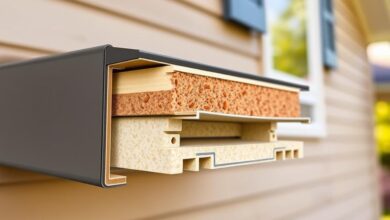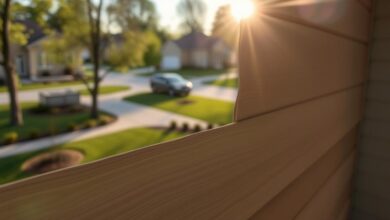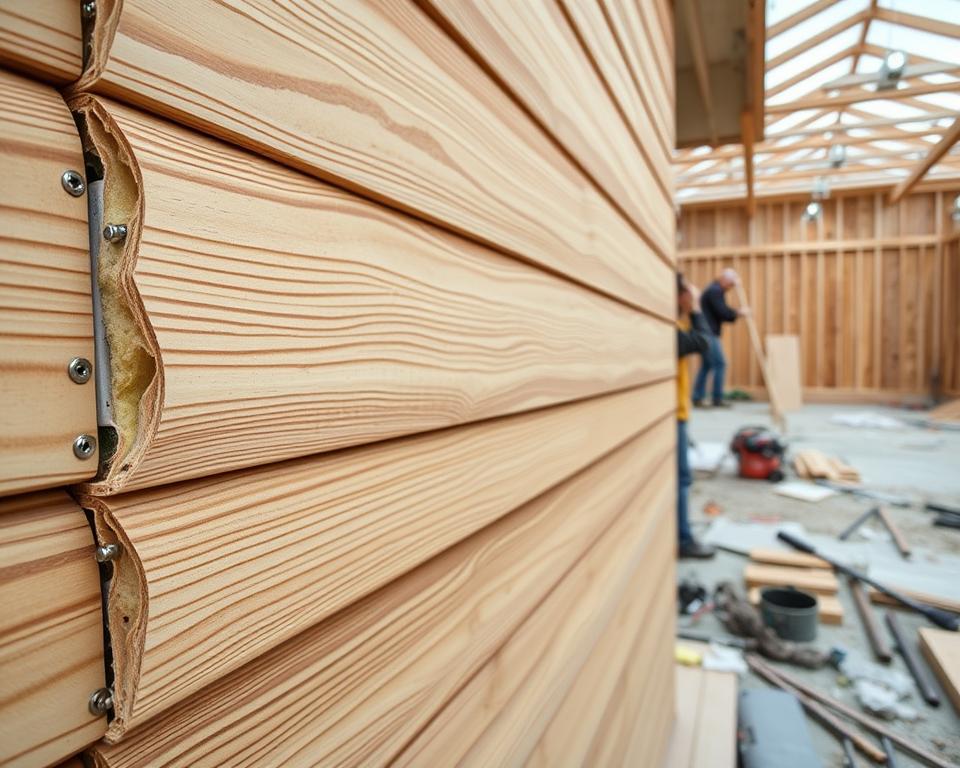Best Insulated Siding for Energy Savings
Looking to cut down on energy bills and make your home more comfortable? Energy efficient siding is a great choice. It acts as a shield against the weather, keeping your home cozy in winter and cool in summer.
With many insulated siding options out there, picking the right one can be tough. This article will help you find the best siding for saving energy. We’ll guide you to make a choice that fits your home’s needs.
Key Takeaways
- Understanding the benefits of energy efficient siding
- Exploring various insulated siding options
- Identifying the best siding for energy efficiency
- Learning how to choose the right siding for your home
- Discovering how to maximize energy savings with the right siding
Understanding Insulated Siding and Its Energy Benefits
Insulated siding is a new way to make your home look better and save energy. It’s becoming popular because it helps lower energy bills and is good for the planet.
What Is Insulated Siding and How It Works
Insulated siding has insulation on the back of the siding. This stops heat from moving in and out of your home. In winter, it keeps warmth in, and in summer, it keeps heat out.
This makes your home’s temperature more stable. You use less energy for heating and cooling.
The Science Behind Energy Loss Through Walls
Walls can lose a lot of energy, making your bills high and your home less comfortable. In winter, walls let heat out, and in summer, they let heat in. This is because of heat transfer, where heat moves from hot to cold areas.
R-Value Explained: The Measure of Insulation Effectiveness
The R-Value shows how well insulation works. A higher R-Value means better insulation. This means more energy savings and a cozier home.
When picking insulated siding, look at the R-Value. It helps you choose the right one for your climate and energy goals.
Knowing how insulated siding works and its benefits helps homeowners make smart choices. This can lead to big energy savings and a greener home.
The Best Insulated Siding Options for Energy Savings
Insulated siding is a big step towards saving energy. There are many great options to pick from. By choosing the right siding, homeowners can cut down their energy costs.
Vinyl Insulated Siding
Vinyl insulated siding is loved for its toughness and easy care. It’s a good mix of saving energy and being affordable.
Top Performing Brands and Models
CertainTeed and Mastic are among the best. They offer siding with high R-Values for different climates.
Typical R-Values and Energy Performance
Vinyl siding’s R-Value ranges from R-2 to R-4. For example, CertainTeed’s Extreme Weather line has an R-Value of R-3.2. It’s great for harsh weather.
Fiber Cement Insulated Siding
Fiber cement siding is also a top pick. It’s strong against pests and fire. Plus, it looks more like traditional siding than vinyl.
Leading Products and Their Specifications
James Hardie is a big name in this field. They make products that are well-insulated and last long.
Energy Efficiency Ratings
Fiber cement siding’s R-Value is usually R-2.5 to R-3.5. James Hardie’s HardiePlank has an R-Value of R-3.1. It’s a smart choice for saving energy.
Insulated Metal and Composite Siding Options
Insulated metal and composite siding are durable and last a long time. They’re also very energy-efficient and can handle tough weather.
Performance in Extreme Climates
Kingspan offers insulated metal siding that does great in harsh weather. Its R-Values can go up to R-6 or more. Composite siding is also very efficient and durable.
When picking insulated siding, think about R-Value, durability, upkeep, and looks. This way, homeowners can choose wisely. They’ll save energy and make their home look better.
“The right insulated siding can reduce energy consumption significantly, leading to lower utility bills and a more comfortable living space.”
How to Choose the Right Insulated Siding for Your Home
To save energy, pick the right insulated siding for your home. This choice depends on your home’s location, the R-Value of the siding, and your budget.
Assessing Your Climate Zone Requirements
First, figure out your climate zone needs. Different areas need different insulation levels. For example, colder areas need more insulation to stay warm, while warmer areas might prefer siding that reflects the sun.
Climate Zone Considerations
| Climate Zone | Recommended R-Value | Siding Material |
|---|---|---|
| Cold Climates | R-4 to R-6 | Vinyl or Fiber Cement |
| Moderate Climates | R-2 to R-4 | Insulated Vinyl or Composite |
| Warm Climates | R-1 to R-2 | Reflective Insulated Siding |
Evaluating R-Values for Your Specific Needs
Knowing the R-Value of your siding is key. The R-Value shows how well the siding keeps heat out. Higher R-Values mean better insulation. Think about local building codes and your energy goals when looking at R-Values.
R-Value Guidelines
- R-1 to R-2: Suitable for warm climates
- R-2 to R-4: Ideal for moderate climates
- R-4 to R-6: Recommended for cold climates
Balancing Energy Efficiency with Budget Constraints
Energy efficiency is important, but so is your budget. Different materials and insulation levels cost differently. Weigh the long-term savings against the upfront cost.
Considering Aesthetic and Durability Factors
Also, think about how the siding looks and lasts. It should be energy-efficient, match your home’s style, and stand up to local weather.
By looking at your climate, R-Values, budget, and aesthetics, you can pick the best insulated siding for your home.
Step-by-Step Installation Guide for Maximum Energy Efficiency
To save energy, it’s key to install insulated siding right. A good installation means your siding works well, saving energy and making your home more comfortable.
Preparation Steps Before Installation
Before you start, prepare the site well. Check the wall’s condition and get all the tools and materials you need.
Assessing Existing Wall Condition
Look for damage or wear on your walls. Check for rot, gaps, or water damage. Fix these problems first for a smooth installation.
Gathering Necessary Tools and Materials
Have all the tools and materials ready before you begin. This includes siding panels, flashing, sealants, and fasteners. Being prepared saves time and avoids delays.
Professional vs. DIY Installation Considerations
Choosing between a pro or DIY depends on your skills, the job’s complexity, and your budget.
DIY can save money but needs time and knowledge. A pro ensures quality but costs more upfront.
Critical Installation Techniques for Energy Performance
The right techniques are key for a successful insulated siding installation. Good sealing and insulation are essential for energy efficiency.
Proper Sealing and Insulation Methods
Make sure all joints and seams are sealed well to stop air leaks. Use quality sealants and follow the instructions.
Common Installation Mistakes to Avoid
Avoid mistakes like wrong alignment, bad sealing, and wrong fastening. These can lower your siding’s performance and waste energy.
By following this guide, you can install your insulated siding correctly. This maximizes its energy-saving benefits and boosts your home’s energy efficiency.
Maintaining and Maximizing Your Insulated Siding Investment
Regular care and checks of your insulated siding boost its performance. Simple maintenance tips help your siding save energy and protect your home.
Seasonal Maintenance Tips
Seasonal checks keep your insulated siding in great shape. In spring, look for winter damage. In fall, clean the siding to remove debris.
- Check for signs of wear and tear.
- Clean the siding with a mild detergent.
- Inspect for gaps or cracks around windows and doors.
When and How to Repair Damaged Sections
Fix damaged sections quickly. Minor damages can be patched easily. But, bigger issues might need a pro.
Complementary Energy-Saving Measures
Keep your insulated siding in good shape and think about other ways to save energy. Window and door sealing helps a lot.
Window and Door Sealing
Seal gaps around windows and doors to stop air leaks. Use weatherstripping or caulk for a tight seal.
Additional Exterior Insulation Options
Adding exterior insulation boosts energy efficiency. You can use foam board or radiant barrier insulation.
| Insulation Type | R-Value | Benefits |
|---|---|---|
| Foam Board | R-4 to R-6 per inch | High R-value, moisture resistant |
| Radiant Barrier | N/A | Reduces radiant heat gain |
By caring for your insulated siding and adding energy-saving steps, you’ll get the most out of your investment. Your home will be more energy-efficient.
Conclusion
Choosing the right insulated siding is key to saving energy at home. There are many options like vinyl, fiber cement, and insulated metal siding. Each has its own advantages and things to think about.
Knowing the R-value and what your climate needs helps you pick the best siding. It’s also important to install and maintain it well. This ensures it works well and lasts longer.
In short, the right insulated siding can cut down energy use and lower bills. It also makes your home more comfortable. By looking at durability, looks, and energy saving, you can choose wisely. This way, you’ll enjoy your siding’s benefits for many years.







